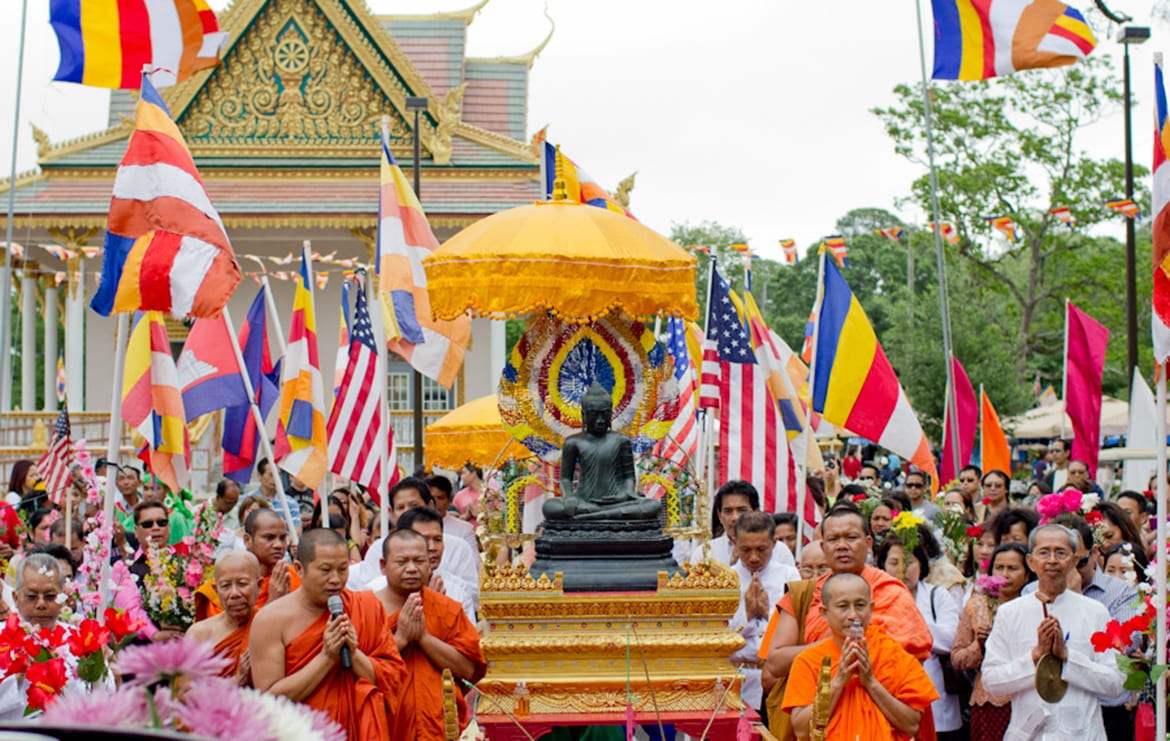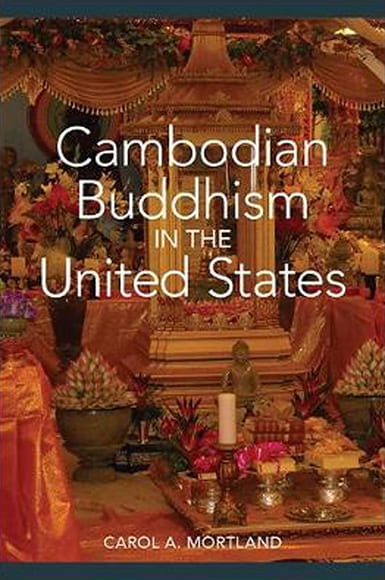
In Review
How Khmer Buddhists Reconstructed Identity and Community in the U.S.
Wat Kantiyaram, Jacksonville, Florida, 2014. Photo by The Rabbit’s Horn Blog
By Chipamong Chowdhury
Like other traditions of Theravada Buddhism from South and Southeast Asia, Khmer/Cambodian Buddhism has been taking root in the United States for several decades. Despite the geographical, national, language, and ethnic differences, Theravada immigrants from South and Southeast Asia are united by their religiosity, values, and practices, all of which center on the concept of Theravada identity. Theravada Buddhism is the state religion of Cambodia. When Cambodian refugees fled to the United States, beginning in the mid-1970s, they rebuilt the culture, tradition, and social norms of Khmer Buddhism by establishing cultural organizations, religious institutions, and temple networks. According to the U.S. Census Bureau (2000), more than 275,000 Khmer descendants reside in America and the vast majority are Theravada Buddhists.
Carol A. Mortland’s Cambodian Buddhism in the United States is the first and most comprehensive anthropological study of Khmer Buddhism in America. Locating Khmer Buddhism within a larger modern global Buddhist network, she examines the complex relationship between transnational Buddhism and Khmer immigrants through meticulous historical and ethnographic research and a study of reports, life histories, and the everyday religious practices of Khmer refugees in the United States. As a cultural anthropologist and director of refugee resettlement programs in New York in the 1980s, Mortland is uniquely positioned to undertake this study. The book is the product of three-and-a-half decades of research on Cambodian religion and immigrants, in Cambodia itself and in various locations across the United States.
The book provides context and a historical backdrop for the study with an introductory overview of the history of Theravada Buddhism’s evolution in Cambodia, followed by a brief narrative of the extreme violence and destruction Khmer Buddhism suffered during the course of the war between Cambodia and Vietnam, the genocide perpetuated by the Khmer Rouge, and structural damage to religious sites inflicted by American bombing campaigns. War and communist violence killed more than three million Cambodian Buddhists between 1968 and 1976 and propelled the migration of Khmer people to North America.
Mortland demonstrates a particular interest in the resettlement of Cambodians following this traumatic history, and the reconstruction of their religious life in the U.S., a history similar to that of Lao Buddhism in America.1 Alternating between personal memoir, history, and qualitative research, she shows how Khmer Buddhists maintain a ritual, religious, and cultural relationship to their homeland as they rebuild Khmer Buddhism through innovation and assimilation. She argues that Khmer Buddhist identity and community in their adopted country are profoundly reshaped by migration, displacement, and social transformation.

Cambodian Buddhism in the United States
Cambodian Buddhism, Mortland writes, “interweaves Buddhist doctrine (dharma), belief in spirits, Brahmanic practices, Taoist principles of humoral balance, and healing practices to provide Cambodians with cultural continuity and a framework for understanding the world and conducting social and political relationships” (17). She finds Cambodian Buddhism to be more of a ritualistic religion than a philosophical or meditative tradition. She notes that “most Cambodians, except those who have served as monks for extended periods of time, know little about Theravada doctrine and are less interested in acquiring Buddhist doctrinal knowledge than in finding comfort and practical ways to improve their lives” (17).
Her study locates temples, monks, and rituals at the core of Khmer Buddhist identity, imagination, representation, and practice in the United States. For Khmer Buddhist immigrants, monasteries and temples are extremely important sites, serving not only worship and ritual but also social and political functions. Temples provide the space within which religion and culture are maintained and enhanced. Here, children learn the fundamentals of Khmer Buddhism, culture, heritage, and language. Bereaved families find a variety of death-related services, including chanting, funerary feeding, prayers, memorial services, sermons, and caregiving.2 The book describes temple organization, structure, and ceremonial life, as well as the various adaptations made within the American context.
Unlike Burmese Buddhist immigrants, who seek spiritual liberation (nibbāna) through vipassanā meditation,3 Khmer Buddhists confine themselves largely to the practice of earning merit. Cambodians’ merit-making activities involve offering dana to monks, veneration of the Buddha and pagodas, and ancestor worship. The merit-making ceremony is therefore the most popular ritual event for accumulating good karma and preparing future better lives. Merit-making also plays a crucial role in fundraising for the temple management in American Khmer society (102).
Khmer Americans continue to regard monks as principle religious leaders, healers, and moral authorities. Mortland writes: “While they could continue practicing Khmer Buddhism in private, they needed monks to assist them in earning merit, and Khmer monks could not live as monks without a temple and a lay community to support them” (115). Thus, for the refugees, a community of monks was essential to the survival of Khmer Buddhism. Mortland describes monastic life, providing stories of the earliest Cambodian monks who migrated to America. Notable was the Venerable Maha Ghos-ananda, who led the rebuilding of Khmer Buddhism both in the U.S. and in Cambodia and called for peace and reconciliation after the overthrow of the Khmer Rouge in 1979.
Among the book’s strengths is an insightful discussion of the beliefs and practices of Khmer Christians and Khmer Muslims in the U.S. Unlike Buddhist refugees who faced many challenges, Cambodian Christian refugees had many privileges in the host land, as they were given jobs, health care, education, and other communal support by Christian aide organizations while in refugee camps and after resettlement. Mortland claims that this was one reason, among others, for the conversion of many Khmer Buddhists to Christianity.
Another strength is the book’s inclusion of an ethnographic account of the persistence and ritual significance of spirit veneration among the Cambodian diaspora communities. However, given its emphasis on religious practices, the book regrettably does not explore the meditative aspect of Khmer Buddhism or document the stories that former monks tell of how they adopted American culture after leaving the monkhood. As with Thai and Lao Buddhist monks, many Cambodian monks quit monastic life after receiving permanent resident status or a Green Card. A discussion of these issues would have further strengthened the book. Nevertheless, the book’s overall value lies in its detailed ethnography, which is well supported by Mortland’s profound knowledge of Khmer religiosity.
Cambodian Buddhism in the United States is a brilliant and highly original work. It makes a crucial contribution to recent scholarship, written for anthropologists, sociologists, historians, and the general public, on the growth of American Buddhism. Some of the chapters will be of much use as textual sources or materials for students in Asian American studies and in courses on American Buddhism and Buddhist studies. Mortland’s research provides some fascinating directions and appeals for the study of religious pluralism and cultural diversity in the U.S. Her book is essential reading for anyone interested in Asian religious histories and practices in America.
Notes:
- Penelope Van Esterik, Taking Refuge: Lao Buddhists in North America (York Lanes, 1992).
- By 2009, as documented by Mortland, there were 109 Khmer Buddhist temples in the United States (113).
- Joseph Cheah, Race and Religion in American Buddhism: White Supremacy and Immigrant Adaptation (Oxford University Press, 2011).
Chipamong Chowdhury is an independent researcher, interpreter, storyteller, and teacher of Buddhist humanities and relational mindfulness. He was a 2017–18 Beyond the Bars Fellow at the Center for Justice at Columbia University.
Please follow our Commentary Guidelines when engaging in discussion on this site.

